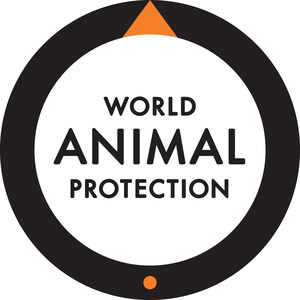NEW YORK, Aug. 12, 2020 /PRNewswire/ -- A new report, containing a Foreword by Jane Goodall, PhD, DBE from World Animal Protection exposes alarming elephant tourism trends across Asia, expected to get worse as venues try to fill the decrease in income due to the COVID-19 pandemic.
Across Asia, there are over 3,800 captive elephants in 357 elephant tourism venues. Thailand is home to three quarters of these elephants and has seen a shocking 70% increase in their numbers in just 10 years according to the third edition of the report, Elephants. Not Commodities. The latest study compares research into elephant tourism spanning a decade, assessing venues across Thailand, India, Laos, Cambodia, Nepal, Sri Lanka and Malaysia.
Tourists are unknowingly driving cruelty with less obviously harmful interactions with elephants, such as bathing and selfies. Our research shows there is a growing awareness that circus-style shows and riding elephants causes suffering. Yet, elephant washing venues have boomed in popularity, with the number of venues in Thailand offering elephant washing activities more than tripling in the last five years. The venues offering these experiences are also often falsely masquerading themselves as "sanctuaries", "rescue centers" and as "ethical", duping well-meaning tourists.
The findings are horrifying, revealing that 2,390 (63%) elephants are suffering in severely dire conditions at 208 venues across the countries studied, and of those just 279 (7%) elephants are kept in high-welfare venues. This is in contrast to 2015, when 2,242 (77%) of elephants lived in severely inadequate conditions, and 194 (7%) lived in high-welfare venues.
Elephants are big business for tourism venues—offering interactions such as shows, riding, bathing, or using them as photo props for selfies. According to the report, before the COVID-19 pandemic, the captive elephant tourism industry generated between $581 to $770 million (USD) of sales per year on the back of elephant suffering.
Audrey Mealia, Global Head of Wildlife at World Animal Protection said:
"For many tourists, traveling to Asia wouldn't be complete without an encounter with an elephant, be it seeing a show, riding or bathing one. Yet sadly, elephant-loving tourists that want that 'once in a lifetime' opportunity, are fueling demand for a mammoth sized problem that causes unthinkable cruelty behind the scenes, even if they don't realize it.
"These intelligent, sociable, creatures are the victims of a trade that exploits them in their thousands. Tourists need to know the truth—any elephant that you can get close enough to touch, is an elephant that's been subjected to horrific abuse for this use. It's not just riding and circus-style shows that involve suffering—it's the bathing and selfie opportunities that you might find at so-called 'sanctuaries,' 'orphanages' or 'rescue centers.' This isn't innocent fun. This is cruelty."
With the industry coming to a complete standstill during the pandemic, many camps were forced to close and lay off their staff, while the remaining ones were left struggling to care for their elephants. World Animal Protection donors have been providing essential funds for 12 ethical, elephant-friendly camps across Asia to help them through this difficult time and keep them afloat.
As a sustainable, long-term solution, World Animal Protection is advocating for a captive breeding ban on elephants used for commercial tourism to ensure future generations are spared this trauma. Tourists also hold considerable power to turn their backs on unethical practices and can opt instead to see elephants in their natural habitat or support elephant-friendly camps. For most captive elephants, being released back into the wild is not possible, so an elephant friendly camp is their best option. These camps work on an observation-only model, still providing jobs and a valuable income to local people such as elephant keepers, known as mahouts.
World Animal Protection is calling on everyone, from travelers, to tourist operators, to take responsibility and put an end to the exploitation of wild animals forever—less demand will mean less elephant suffering.
The organization is also calling on G20 leaders to enforce a global wildlife trade ban to eliminate the threats of future pandemics to our health and economies.
Notes to the Editor:
- Sign the petition to ban the global wildlife trade here
- Donate to the elephant appeal here
- In 2017, World Animal Protection launched the first comprehensive assessment of elephants in Asia, Taken for a Ride. The report documents the conditions endured by nearly 3,000 elephants used in tourist venues across Asia. 220 venues were surveyed between late 2014 and mid-2016, including all venues that could be identified in Thailand, Laos, Cambodia, Nepal and Sri Lanka, and a representative selection of venues in India. It follows World Animal Protection's first survey in 2010 covering the conditions of elephants in entertainment in Thailand, called Wildlife on a Tightrope.
Breakdown by country:
Thailand |
Attracts 39.8 million tourists in 2019, is home to nearly three quarters (73%) of the captive elephants used for tourism in Asia, or 2,798 elephants. Between 2010 and 2020, there was a dramatic 135% increase in the number of elephants living in severely inadequate conditions in the country. |
India |
Home to the second highest number of elephants used in tourism, and of the 21 venues housing 509 elephants, the report found 45% (225) of the elephants were kept in severely inadequate conditions. |
Sri Lanka |
13 venues housing 188 elephants were assessed which was an increase of 13% or 22 elephants held captive since 2015. More elephants were living in severely inadequate conditions—24% (46) compared to 22% (36) of elephants in 2015. |
Cambodia |
64 elephants at 10 venues were assessed, showing that 38% (24) of elephants were living in severely inadequate conditions. |
Nepal |
143 elephants at 55 venues were assessed, finding the number of captive elephants in Nepal has decreased by 8% between 2015 and 2020, from 155 to 143 elephants. We also found that between 2015 and 2020, the percentage of elephants living in severely inadequate conditions decreased. |
Laos |
105 elephants across 11 venues were assessed showing the number of venues has increased by 83% (6) and the number of elephants by 78% (46) elephants since 2015. Just under half 48% (50) of elephants were living in severely inadequate conditions and 15% (16) living in improved conditions. |
Malaysia |
30 elephants were assessed at the sole identified elephant tourism venue, where the elephants lived in improved, yet still inadequate conditions. |
SOURCE World Animal Protection

Related Links
http://www.worldanimalprotection.us.org
WANT YOUR COMPANY'S NEWS FEATURED ON PRNEWSWIRE.COM?
Newsrooms &
Influencers
Digital Media
Outlets
Journalists
Opted In



Share this article